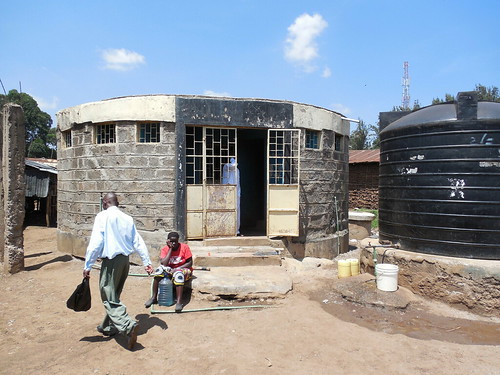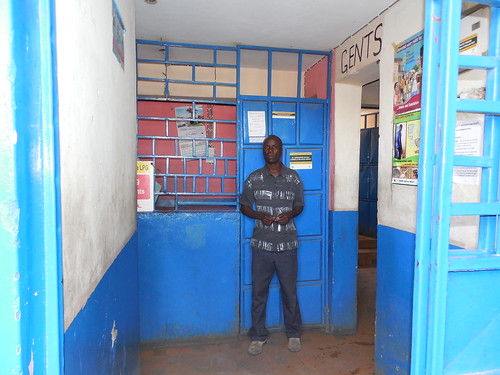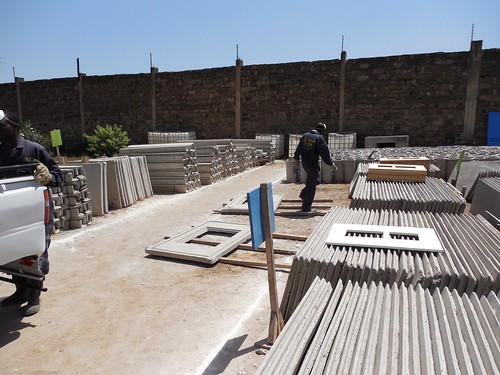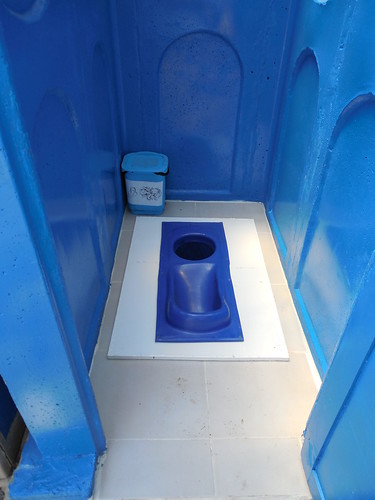- Markets, finance and governance
- Sanitation as a business and business models
- A brief report about some sanitation initiatives in Kibera and other slums of Nairobi (Umande Trust biogas, Sanergy)
A brief report about some sanitation initiatives in Kibera and other slums of Nairobi (Umande Trust biogas, Sanergy)
6836 views
Re: A brief report about some sanitation initiatives in Kibera and other slums of Nairobi (Umande Trust biogas, Sanergy)
What could also be interesting for you is the Up-scaling basic Sanitation for the urban poor programme. Most information you can get from here: forum.susana.org/forum/categories/167-ma...t-fund-and-giz-kenya
and the Water Services Trust Fund Website under the urban programme: waterfund.go.ke/
UDDTs is one of the technologies being promoted in this programme and it targets all low income areas in the country. Our focus is the sanitation value chain. We are currently in the scaling up phase with 20 water companies receiving funding for implementation.
Best regards,
Doreen
and the Water Services Trust Fund Website under the urban programme: waterfund.go.ke/
UDDTs is one of the technologies being promoted in this programme and it targets all low income areas in the country. Our focus is the sanitation value chain. We are currently in the scaling up phase with 20 water companies receiving funding for implementation.
Best regards,
Doreen
Doreen Mbalo
GIZ Sustainable Sanitation Programme
Policy Advisor in Bonn, Germany
Deutsche Gesellschaft für Internationale Zusammenarbeit (GIZ) GmbH
E This email address is being protected from spambots. You need JavaScript enabled to view it.
GIZ Sustainable Sanitation Programme
Policy Advisor in Bonn, Germany
Deutsche Gesellschaft für Internationale Zusammenarbeit (GIZ) GmbH
E This email address is being protected from spambots. You need JavaScript enabled to view it.
Please Log in to join the conversation.
You need to login to replyRe: A brief report about some sanitation initiatives in Kibera and other slums of Nairobi (Umande Trust biogas, Sanergy)
PS to my previous post:
1 KSh = +- 1 dollar cent (US)
That raises the following additional question:
- How much are the residents of the Nairobi slums earning, those in particular who are earning least?
If you assume the proverbial 2 dollars a day, i.e. 200 KSh a day, or possibly 6000 KSh a month, five shillings for going to the toilet would appear a lot of money, especially if you think of all the dependents who are also living on that income!
I personally like the family rate of 150 shillings per month, of which I have heard once only during my trip (if I remember correctly). That would mean only 2.5 % of available income on a 2 dollar per day basis. That looks affordable!
Hanns-André
1 KSh = +- 1 dollar cent (US)
That raises the following additional question:
- How much are the residents of the Nairobi slums earning, those in particular who are earning least?
If you assume the proverbial 2 dollars a day, i.e. 200 KSh a day, or possibly 6000 KSh a month, five shillings for going to the toilet would appear a lot of money, especially if you think of all the dependents who are also living on that income!
I personally like the family rate of 150 shillings per month, of which I have heard once only during my trip (if I remember correctly). That would mean only 2.5 % of available income on a 2 dollar per day basis. That looks affordable!
Hanns-André
Hanns-Andre Pitot
M.Eng. Environmental Pollution Control
presently in Seesen, Germany
M.Eng. Environmental Pollution Control
presently in Seesen, Germany
Please Log in to join the conversation.
You need to login to replyA brief report about some sanitation initiatives in Kibera and other slums of Nairobi (Umande Trust biogas, Sanergy)
Dear all,
In January of this year, I visited some of the slum areas of Nairobi, Kibera in particular, in search of the sanitation and ecosan facilities that are being used, and I also visited the Sanergy field office. I have posted some photos of these field trips on the Susana Flickr site.
See the entire set:
www.flickr.com/photos/gtzecosan/sets/72157654517569469
Example photo from this set:
 View of Kibera with a river
by
SuSanA Secretariat
, on Flickr
View of Kibera with a river
by
SuSanA Secretariat
, on Flickr
These now are some personal impressions and some questions that I wish to share.
The toilet facilities of the slum areas I have seen were dominated by Umande Trust, an organization that is constructing biogas toilets as community centers. Most of my photos are showing views of these toilets as well as of the slum areas.
For example:
 Umande Trust: Toilet facility
by
SuSanA Secretariat
, on Flickr
Umande Trust: Toilet facility
by
SuSanA Secretariat
, on Flickr
 Umande Trust: entrance of a biogas toilet
by
SuSanA Secretariat
, on Flickr
Umande Trust: entrance of a biogas toilet
by
SuSanA Secretariat
, on Flickr
The toilet buildings of Umande Trust are comprised of many stands of toilets and showers, plus usually a community room on top. The toilets are of the regular pour flush type (so nothing special, except from one UDDT that I also saw), and the gas of the toilets is usually used for heating water for showering. The rates charged at these toilets are as follows (for the Kidijote Center): 5 KSh for use of a toilet, 10 KSh for a cold shower, 15 KSh for a hot shower. There also is a family rate of 150 KSh per month for the use of the toilets. Apparently, extra revenues are used for communal activities (since the "bio centers" are meant to be communal centers rather than just toilets and showering facilities).
The waste water from the biodigestors was treated at one of the toilets (see the photo below), it was discharged without treatment in another case, and removed by pit emptiers in others.
 Umande Trust: on site treatment of waste water
by
SuSanA Secretariat
, on Flickr
Umande Trust: on site treatment of waste water
by
SuSanA Secretariat
, on Flickr
Umande Trust is planing a treatment center for the waste water from its toilets using further anaerobic treatment with additional organic material. The expected products are expected to be compost and liquid fertilizer.
In Kibera, there was one large toilet complex belonging to the Human Needs Project. Here, the toilets are regular flush toilets. There are also showers, and the waste water is treated and recycled for flushing the toilets. Water for the showers is heated using solar collectors (so the appears quite high tech).
Concerning the visit at the Sanergy field office, I think I don't need to introduce the organization, since they already have done so in quite some detail. See, for example, in a recent post:
forum.susana.org/forum/categories/98-res...-scale-sanergy-kenya
The toilets are prefabricated using components made of reinforced concrete, wood and plastic.
 Sanergy: storage of components
by
SuSanA Secretariat
, on Flickr
Sanergy: storage of components
by
SuSanA Secretariat
, on Flickr
They are of the urine diverting bucket type and need to be serviced at least once every day. The solids are further treated by composting (and urine, I suppose, by storage). Unfortunately, I wasn't able to see the composting part, which is performed out of town. So, I cannot report about that. I also didn't see any of the Sanergy toilets in operation, so I cannot report about the user experience for these toilets.
 Sanergy: interior of the old toilet model
by
SuSanA Secretariat
, on Flickr
Sanergy: interior of the old toilet model
by
SuSanA Secretariat
, on Flickr
Fees are similar as for Umande Trust, i.e. 3 - 5 KSh per use. Operators are paying 600 dollars for the construction of one toilet and the first year of servicing, and 100 dollars for each additional year of servicing. They can earn about 1000 dollars a year assuming up to 80 uses per day. Sanergy is hoping to cover its costs of servicing the toilets (collection and composting) with the servicing fees and the sale of the resulting compost. Other products, like insect larvae, are being researched. From the figures I was given, the compost product should result in another - roughly speaking - 1000 dollars of revenues per toilet and year. Sanergy apparently believes that a high selling price for their compost is justified since there are large farms in the Nairobi area that have shown great interest in the fertilizer products.
I think the nice thing about the approaches of both Sanergy and Umande Trust is that they are aiming at completely closing the loop for solids and nutrients, and that they are both cost covering in terms of operating costs. In addition, the Sanergy approach looks as though it is self sustaining in the sense that it does not need an initial investment into toilets from outside since the operators are buying the relatively cheep toilets. Umande Trust, on the other hand, is also providing 'cleanliness' in the form of hot showers.
Note: This report does not, by any means, claim to be a complete report of the (ecological) sanitation situation of the slums of Nairobi.
Questions:
To Umande Trust:
1. In order for the 'loop' to be closed, the existing toilets require the envisaged treatment center - when is it supposed to be operational?
2. Is there any chance that the investment costs for additional toilets will be covered by income from existing ones?
To Sanergy:
- Would it be possible to publish chemical analyses of the compost product in terms of nutrients, heavy metals, etc.?
To other Nairobians:
- What would still be missing in order to make this report more complete with respect to the (ecological) sanitation situation in the Nairobi slum/ low income areas?
Regards to everybody,
Hanns-André
In January of this year, I visited some of the slum areas of Nairobi, Kibera in particular, in search of the sanitation and ecosan facilities that are being used, and I also visited the Sanergy field office. I have posted some photos of these field trips on the Susana Flickr site.
See the entire set:
www.flickr.com/photos/gtzecosan/sets/72157654517569469
Example photo from this set:

These now are some personal impressions and some questions that I wish to share.
The toilet facilities of the slum areas I have seen were dominated by Umande Trust, an organization that is constructing biogas toilets as community centers. Most of my photos are showing views of these toilets as well as of the slum areas.
For example:


The toilet buildings of Umande Trust are comprised of many stands of toilets and showers, plus usually a community room on top. The toilets are of the regular pour flush type (so nothing special, except from one UDDT that I also saw), and the gas of the toilets is usually used for heating water for showering. The rates charged at these toilets are as follows (for the Kidijote Center): 5 KSh for use of a toilet, 10 KSh for a cold shower, 15 KSh for a hot shower. There also is a family rate of 150 KSh per month for the use of the toilets. Apparently, extra revenues are used for communal activities (since the "bio centers" are meant to be communal centers rather than just toilets and showering facilities).
The waste water from the biodigestors was treated at one of the toilets (see the photo below), it was discharged without treatment in another case, and removed by pit emptiers in others.

Umande Trust is planing a treatment center for the waste water from its toilets using further anaerobic treatment with additional organic material. The expected products are expected to be compost and liquid fertilizer.
In Kibera, there was one large toilet complex belonging to the Human Needs Project. Here, the toilets are regular flush toilets. There are also showers, and the waste water is treated and recycled for flushing the toilets. Water for the showers is heated using solar collectors (so the appears quite high tech).
Concerning the visit at the Sanergy field office, I think I don't need to introduce the organization, since they already have done so in quite some detail. See, for example, in a recent post:
forum.susana.org/forum/categories/98-res...-scale-sanergy-kenya
The toilets are prefabricated using components made of reinforced concrete, wood and plastic.

They are of the urine diverting bucket type and need to be serviced at least once every day. The solids are further treated by composting (and urine, I suppose, by storage). Unfortunately, I wasn't able to see the composting part, which is performed out of town. So, I cannot report about that. I also didn't see any of the Sanergy toilets in operation, so I cannot report about the user experience for these toilets.

Fees are similar as for Umande Trust, i.e. 3 - 5 KSh per use. Operators are paying 600 dollars for the construction of one toilet and the first year of servicing, and 100 dollars for each additional year of servicing. They can earn about 1000 dollars a year assuming up to 80 uses per day. Sanergy is hoping to cover its costs of servicing the toilets (collection and composting) with the servicing fees and the sale of the resulting compost. Other products, like insect larvae, are being researched. From the figures I was given, the compost product should result in another - roughly speaking - 1000 dollars of revenues per toilet and year. Sanergy apparently believes that a high selling price for their compost is justified since there are large farms in the Nairobi area that have shown great interest in the fertilizer products.
I think the nice thing about the approaches of both Sanergy and Umande Trust is that they are aiming at completely closing the loop for solids and nutrients, and that they are both cost covering in terms of operating costs. In addition, the Sanergy approach looks as though it is self sustaining in the sense that it does not need an initial investment into toilets from outside since the operators are buying the relatively cheep toilets. Umande Trust, on the other hand, is also providing 'cleanliness' in the form of hot showers.
Note: This report does not, by any means, claim to be a complete report of the (ecological) sanitation situation of the slums of Nairobi.
Questions:
To Umande Trust:
1. In order for the 'loop' to be closed, the existing toilets require the envisaged treatment center - when is it supposed to be operational?
2. Is there any chance that the investment costs for additional toilets will be covered by income from existing ones?
To Sanergy:
- Would it be possible to publish chemical analyses of the compost product in terms of nutrients, heavy metals, etc.?
To other Nairobians:
- What would still be missing in order to make this report more complete with respect to the (ecological) sanitation situation in the Nairobi slum/ low income areas?
Regards to everybody,
Hanns-André
Hanns-Andre Pitot
M.Eng. Environmental Pollution Control
presently in Seesen, Germany
M.Eng. Environmental Pollution Control
presently in Seesen, Germany
The following user(s) like this post: JKMakowka
Please Log in to join the conversation.
You need to login to reply
Share this thread:
- Markets, finance and governance
- Sanitation as a business and business models
- A brief report about some sanitation initiatives in Kibera and other slums of Nairobi (Umande Trust biogas, Sanergy)
Recently active users. Who else has been active?
Time to create page: 0.083 seconds








